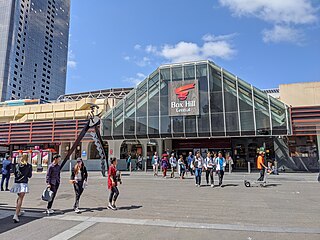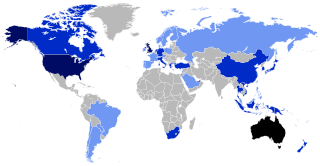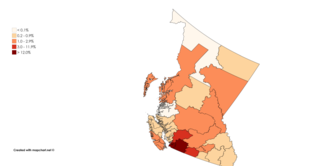Related Research Articles

Desi is a loose term used to describe the people, cultures, and products of the Indian subcontinent and their diaspora, derived from Sanskrit देश (deśá), meaning 'land, country'. Desi traces its origin to the people from the South Asian republics of India, Pakistan and Bangladesh, and may also sometimes include people from Nepal, Sri Lanka, Bhutan, Afghanistan, and the Maldives.
The terms multiracial people or mixed-race people refer to people who are of more than one race and the terms multi-ethnic people or ethnically mixed people refer to people who are of more than one ethnicity. A variety of terms have been used both historically and presently for mixed-race people in a variety of contexts, including multiethnic, polyethnic, occasionally bi-ethnic, Métis, Muwallad, Coloured, Dougla, half-caste, ʻafakasi, mestizo, mutt, Melungeon, quadroon, octoroon, sambo/zambo, Eurasian, hapa, hāfu, Garifuna, pardo, and Gurans. A number of these terms are now considered offensive, in addition to those that were initially coined for pejorative use. "Melezi" are called the offspring of Muslim Romani men and woman of host populations.

Anglo-Indian people fall into three different groups: people of mixed-race origin with Indian and British ancestry, people of unmixed Indian descent born or living in the United Kingdom, and people of unmixed British descent born or living in India. The latter sense is now mostly historical. People fitting the middle definition are more usually known as British Asian or British Indian. This article focuses primarily on the modern definition, a distinct minority community of mixed-race Eurasian ancestry, whose first language is ordinarily English.

South Asian Canadians are Canadians who were either born in or can trace their ancestry to the Indian subcontinent, which includes the nations of India, Pakistan, Bangladesh, Nepal, Sri Lanka, Bhutan, and the Maldives.

British Asians are British people of Asian descent. They constitute a significant and growing minority of the people living in the United Kingdom, with 6.9% of the population identifying as Asian/Asian British in the 2011 United Kingdom census. This represented a national demographic increase from a 4.4% share of UK population in 2001.
Burmese people or Myanma people are citizens or people from Myanmar (Burma), irrespective of their ethnic or religious background. Myanmar is a multi-ethnic, multi-cultural and multi-lingual country. The Burmese government officially recognises 135 ethnic groups, who are grouped into eight 'national races,' namely the Bamar (Burmans), Shan, Karen, Rakhine (Arakanese), Mon, Kachin, Chin, and Kayah (Karenni). Many ethnic and ethnoreligious communities exist outside these defined groupings, such as the Burmese Chinese and Panthay, Burmese Indians, Anglo-Burmese, and Gurkhas.

Mauritians are nationals or natives of the Republic of Mauritius and their descendants. Mauritius is a multi-ethnic society, with notable groups of people of South Asian, Sub-Saharan African, European, and Chinese descent, as well as those of a mixed background from any combination of the aforementioned ethnic groups.

Indian people or Indians are the citizens and nationals of the Republic of India. In 2022, the population of India stood at 1.4 billion people. According to UN forecasts, India overtook China as the world's most populous country by the end of April 2023, containing 17.50 percent of the global population. In addition to the Indian population, the Indian overseas diaspora also boasts large numbers, particularly in the Arab states of the Persian Gulf and the Western world.

British Indians are citizens of the United Kingdom (UK) whose ancestral roots are from India. Currently, the British Indian population exceeds 1.8 million people in the UK, making them the single largest visible ethnic minority population in the country. They make up the largest subgroup of British Asians and are one of the largest Indian communities in the Indian diaspora, mainly due to the Indian–British relations. The British Indian community is the sixth largest in the Indian diaspora, behind the Indian communities in the United States, Saudi Arabia, the United Arab Emirates, Malaysia and Nepal. The majority of British Indians are of Punjabi and Gujarati origin with various other smaller communities from different parts of India including Kerala, West Bengal, Bihar and Uttar Pradesh.

An ethnoburb is a suburban residential and business area with a notable cluster of a particular ethnic minority population, which may or may not be a local majority. That can greatly influence the social geography within the area because of distinct cultural and religious values. Ethnoburbs allow for ethnic minority groups to maintain their traditional identity, forestalling cultural assimilation.

Australians, colloquially known as Aussies, are the citizens, nationals and individuals associated with the country of Australia. This connection may be residential, legal, historical or ethno-cultural. For most Australians, several of these connections exist and are collectively the source of their being Australian. Australian law does not provide for a racial or ethnic component of nationality, instead relying on citizenship as a legal status.

Indo-Canadians or Indian Canadians, are Canadians who have ancestry from India. The term East Indian is sometimes used to avoid confusion with the Indigenous peoples of Canada. Categorically, Indo-Canadians comprise a subgroup of South Asian Canadians which is a further subgroup of Asian Canadians. According to Statistics Canada, Indians are one of the fastest growing communities in Canada and one of the largest non-European ethnic groups.
Asian people are the people of Asia. The term may also refer to their descendants. According to the Merriam-Webster dictionary, an Asian is “a person of Asian descent”.
Indo-Fijians, also known as Indian Fijians, are Fijian citizens of Indian descent, and include people who trace their ancestry to various regions of the Indian subcontinent. Although Indo-Fijians constituted a majority of Fiji's population from 1956 through the late 1980s, discrimination and the resulting brain drain resulted in them numbering 313,798 (37.6%) out of a total of 827,900 people living in Fiji as of 2007.

Non-Hispanic Whites, Non-Latino Whites, or more simply White Americans, are Americans classified by the United States census as "white" and not Hispanic. According to the United States Census Bureau yearly estimates, as of July 1, 2022, Non-Hispanic whites make up about 59.3% of the U.S. population, or 197,639,521 people. The United States Census Bureau defines white to include European Americans, Middle Eastern Americans, and North African Americans. Americans of European ancestry are divided into various ethnic groups. More than half of the white population are German, Irish, English, French and Polish Americans. Many Americans are also the product of other European groups that migrated to parts of the US in the 19th and 20th centuries, as the bulk of immigrants from various countries in Northern, Central, Eastern, and Southeastern Europe, as well as the Caucasus region, migrated to the United States.

Overseas Indians, officially Non-Resident Indians (NRIs) and People of Indian Origin (PIOs) are Indians who reside or originate outside of India. According to the Government of India, Non-Resident Indians are citizens of India who currently are not living in India, while the term People of Indian Origin refers to people of Indian birth or ancestry who are citizens of countries other than India. Overseas Citizenship of India (OCI) is given to People of Indian Origin and to persons who are not People of Indian Origin but married to Indian citizen or People of Indian Origin. Persons with OCI status are known as Overseas Citizens of India (OCIs). The OCI status is a permanent visa for visiting India with a foreign passport.
Visible minorities have become highly concentrated in Vancouver and its suburbs. The proportion of visible minorities in Vancouver increased from 14 percent to 55 percent of the population between 1981 and 2021. Vancouver has less residential segregation of its ethnic minorities compared to older Canadian cities such as Montreal. However, Vancouver exhibits some residential segregation, as demographic data shows visible minority concentrations vary by neighbourhood in Vancouver. In general, East Vancouver has higher visible minority concentrations than the West Side. Higher visible minority concentrations are also found in nearby suburbs such as Richmond, Surrey, Burnaby, and New Westminster. Most recent immigrants choose to locate in peripheral neighbourhoods in Greater Vancouver. It is speculated that Canada's multiculturalism policies may have prevented greater segregation from the dominant groups in both the residential location and the labour market.
Kutcha butcha is a Hindi phrase that means "half-baked child,” and is used to refer to biracial people of Indian and (white) British ancestry. The expression consists of two words: kutcha, meaning “uncooked” or “underdone,” and butcha, which literally means “child.” The two words together translate roughly as a child who resembles half-baked bread. It is primarily a derogatory term, meant to indicate the inadequacy of the individual, being neither Indian nor British, and it emphasizes the lack of belonging generally experienced by these individuals. Kutcha butcha is colloquially synonymous with half-caste, terminology that is characteristic of hypodescent, which occurs when offspring of mixed-race unions are assigned to the ethnic group that is perceived by the dominant group as being subordinate.

The South Asian community in British Columbia was first established in 1897. The first immigrants originated from Punjab, British India, a northern region and state in modern-day India and Pakistan. Punjabis originally settled in rural British Columbia at the turn of the twentieth century, working in the forestry and agricultural industries.
The Malaysian diaspora are Malaysian emigrants from Malaysia and their descendants that reside in a foreign country. Population estimates vary from seven hundred thousand to one million, both descendants of early emigrants from Malaysia, as well as more recent emigrants from Malaysia. The largest of these foreign communities are in Singapore, Australia, Brunei and the United Kingdom.
References
- ↑ Government of Canada, Statistics Canada (2022-10-26). "Ethnic or cultural origin by gender and age: Canada, provinces and territories, census metropolitan areas and census agglomerations with parts". www12.statcan.gc.ca. Retrieved 2024-05-05.
- ↑ "India challenges China as top immigration source to Canada". Workpermit.com. 14 November 2006. Retrieved 28 December 2014.